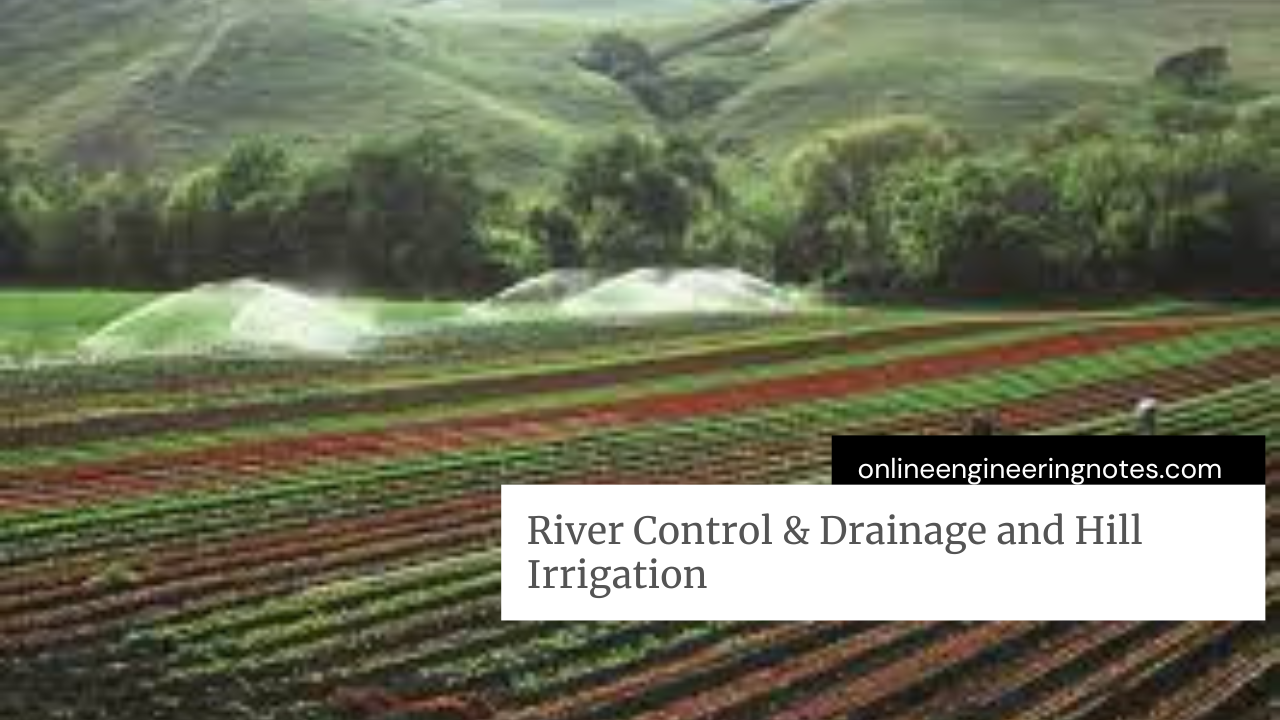1.1 Effects of water logging and their control:
- An agricultural land is said to be water logged if productivity gets affected by high water table.
- Due to high water in root zone, oxygen gets removed and bacteria cannot get enough air to produce sufficient food for plant.
- Cause:
- Over irrigation.
- Seepage of water through canal.
- Excessive rain.
- Irregular or flat topography.
- Inadequate surface and natural drainage.
- Effects:
- Hamper’s nitrification.
- Cultivation operation becomes difficult.
- Restricted root growth.
- Leads to salinity (presence of salt).
- Control:
- Lining of canal and water course.
- Reduce intensity of irrigation.
- Crop rotation.
- Increase natural drain.
- Optimum use of water.
1.2 Consideration in the design of surface and sub-surface drainage system:
Drainage:
- Process of taking out excess water from irrigated land to minimize water logging.
Types:
1. Open or surface drainage:
- Constructed at land surface having open channel flow in drain.
- Types of open or surface drainage:
a. Shallow drain:
- Depth of drain is small.
- Used to accelerate storm water removal.
b. Deep open drain:
- Depth of drain is large.
- Used to discharge collected rain and seepage water safely to natural drain.
Design consideration of surface drainage:
- If ground has good natural slope no drain required.
- Drain are required for area having very mild slope and heavy rainfall.
- Alignment should follow natural slope.
- Strom water should drain with 3 to 5 days.
2. Subsurface irrigation:
- Drainage of water through underground drains.
- Subsurface irrigation:
- Also known as drip irrigation.
- Effective for coarse texural soil.
- Cultivable land loss is minimum.
1.3 Objective of river training:
River training work:
- River training work is known as all engineering work which are constructed to guide, controll or regulate river.
Objective of river training work:
- To prevent river from changing it course.
- To provide safe passage of flood.
- To protect river bank.
- To ensure effective disposal of sediment load.
- To control and regulate river.
1.4 Types of river training work:
1. High water training:
- Purpose to control flood.
- Protect land from flood.
2. Low water training:
- Provide sufficient water depth for navigation.
- Groyne’s are constructed to contact the width of channel and increase the depth.
3. Mean water training:
- Effeciently dispose suspended and bed load.
- Example: Check dam.
1.5 Specific design consideration in hill irrigation:
- The length of canal should kept short as possible.
- Local manpower and locally available material should be utilized.
- Proper design should be adopted so that farmers can easily maintain and repair.
- Non-modular and semi- modular outlet are used.
- Slope should be cut to maintain uniform gentle gradient.
- Manning’s equation is used to design canal.
- Narrow canal is used to reduce risk of erosion and seepage.
1.6 Choice of intake, control and regulation structure:
Intake:
- Used for collecting water from the surface source such as river, lake and conveying it for irrigation purpose.
Selection criteria of intake:
- Sufficient flow is available in both monsoon and dry season.
- Sufficient availabiluty of head of water.
Sedimentation control of river:
- By construction of intake outside the river bank.
- Afforestation.
- Use of divide wall.
- Construction of setting basin.
1.7 Environmental protection measure in hill irrigation:
Problem:
- Mass movement.
- Weathering due to high velocity.
- Cutting of river.
Solution:
- Construction of small dams.
- Construction of retaining wall.
- Construction of surface and sub-surface drainage.
- Bamboo planting can be used for soil erosion on slope.
- Use of stone pitching to reduce velocity of water.
References:
- WECS (1998), Design Guidelines for Surface Irrigation in Terai and Hills of Nepal, (Vol. I and II)
- Michael, A.M.(2011). Irrigation theory and practice
- FAO(1977). Guidelines for Predicting Crop Water Requirements. FAO Irrigation and Drainage Paper No. 24.

